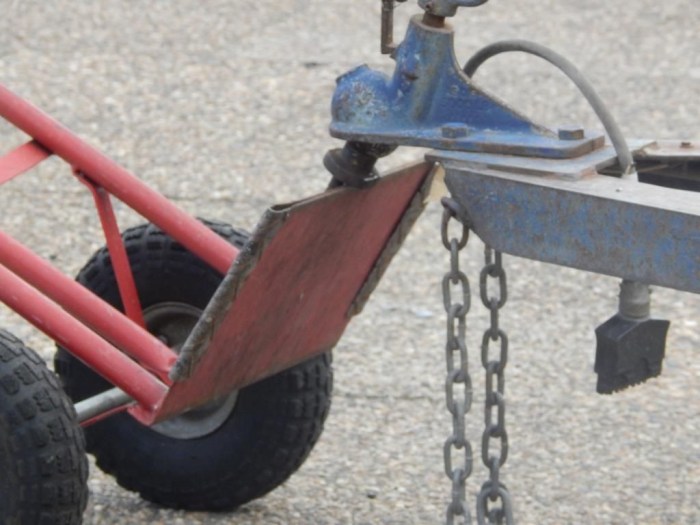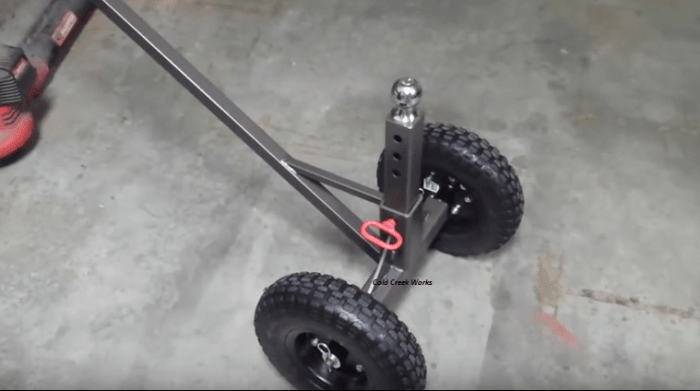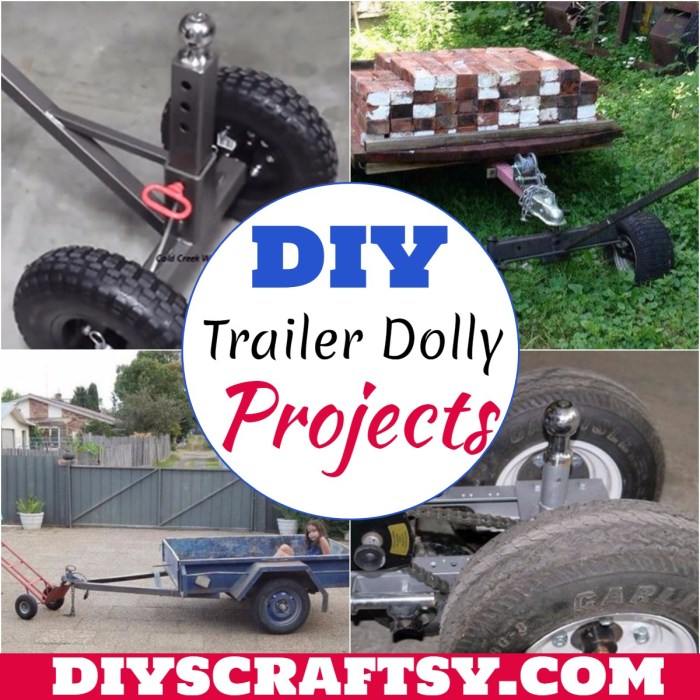Diy trailer dolly – DIY trailer dollies are a popular project for those who want to save money and customize their towing experience. Whether you’re a seasoned DIYer or a beginner, building your own trailer dolly can be a rewarding and practical endeavor.
From choosing the right materials to assembling the dolly, this guide will walk you through the entire process, providing detailed instructions and tips along the way. With a little effort and ingenuity, you can create a sturdy and reliable trailer dolly that meets your specific needs.
What is a DIY Trailer Dolly?

A DIY trailer dolly is a wheeled platform designed to move trailers or heavy objects around, typically for short distances. It is built using readily available materials and tools, making it a cost-effective and versatile solution for various tasks.
Purpose and Uses
A DIY trailer dolly serves as a mobile platform to maneuver trailers or heavy objects, simplifying the process of moving them around. This is especially beneficial when dealing with trailers that lack a jack or when the terrain is uneven, making it difficult to maneuver the trailer manually.
Here are some common uses for a DIY trailer dolly:
- Moving trailers around a garage or workshop.
- Transporting trailers to and from storage areas.
- Positioning trailers for loading and unloading.
- Moving heavy objects, such as appliances or furniture, within a limited space.
Benefits of Building a DIY Trailer Dolly
Building a DIY trailer dolly offers several advantages compared to purchasing a ready-made one:
- Cost-effectiveness: Building your own dolly allows you to utilize readily available materials and tools, significantly reducing the overall cost compared to purchasing a pre-built dolly. This is particularly advantageous for individuals on a budget.
- Customization: A DIY trailer dolly allows for customization to meet specific needs and requirements. You can adjust the size, weight capacity, and features of the dolly based on your intended use. This flexibility ensures that the dolly is perfectly suited for your specific application.
- Learning experience: Building a DIY trailer dolly is a rewarding experience that allows you to learn new skills and gain valuable knowledge about construction and mechanics. The process of designing, building, and testing the dolly can be both enjoyable and educational.
Step-by-Step Construction Guide

Building a DIY trailer dolly is a straightforward process that can be accomplished with basic tools and materials. This guide will provide you with a detailed step-by-step construction plan, helping you create a sturdy and reliable dolly for your trailer.
Gathering Materials
The first step in building a trailer dolly is to gather the necessary materials. The materials will vary depending on the size and weight of the trailer you plan to move. However, some common materials include:
- Two heavy-duty steel or wooden beams (for the base)
- Four heavy-duty wheels (consider the weight of the trailer and the terrain you’ll be using the dolly on)
- Steel or wooden supports for the base (to create a stable platform)
- Fasteners (bolts, nuts, washers) to secure the components together
- A welding machine or strong wood glue and clamps (depending on the materials you choose)
- Paint (optional, for protection and aesthetics)
It’s essential to choose high-quality materials that can withstand the weight of your trailer. For example, consider using steel beams for the base if you’re moving a heavy trailer.
Assembling the Base
The base of the trailer dolly provides the primary support for the trailer.
- Measure and cut the beams: Measure the length of the beams based on the width of your trailer’s axle. Cut the beams to the desired length using a saw.
- Attach the beams: Secure the two beams together to form a rectangular frame. You can use welding, strong wood glue, or heavy-duty bolts and nuts to connect the beams. Ensure the frame is strong and rigid.
- Add supports: Attach supports to the base frame to create a stable platform. These supports can be made of wood or steel, depending on the materials you chose. They should be positioned strategically to provide adequate support for the trailer’s weight.
Attaching the Wheels
The wheels are crucial for maneuverability and ease of movement.
- Choose the right wheels: Select wheels that are suitable for the weight of your trailer and the terrain you’ll be using the dolly on. For heavy trailers, consider using heavy-duty wheels with bearings for smooth rolling.
- Position the wheels: Determine the placement of the wheels on the base frame. Ensure they are evenly spaced to distribute the weight of the trailer evenly.
- Secure the wheels: Attach the wheels to the base frame using bolts, nuts, and washers. Make sure the wheels are securely fastened to prevent them from detaching during use.
Final Touches
Once the base and wheels are assembled, you can add final touches to enhance the durability and appearance of your trailer dolly.
- Reinforce the structure: Consider adding additional bracing or supports to the base frame to increase its rigidity and strength. This is especially important if you’re moving a heavy trailer.
- Apply paint: Paint the trailer dolly to protect it from rust and corrosion. Choose a durable paint that can withstand the elements and wear and tear.
Troubleshooting Tips
Even with careful construction, you might encounter some challenges during the process. Here are some common issues and troubleshooting tips:
- Uneven base: If the base frame is uneven, it can lead to instability and difficulty moving the trailer. Ensure the base frame is level and all four corners are at the same height.
- Loose connections: Check all connections, including bolts, nuts, and welds, to ensure they are tight and secure. Loose connections can lead to instability and safety hazards.
- Wheels not rolling smoothly: If the wheels are not rolling smoothly, check for debris or dirt in the bearings. Clean the bearings and lubricate them with grease for smooth operation.
Remember to always prioritize safety when working with tools and heavy equipment. Wear appropriate safety gear, including gloves and eye protection.
Customization and Modifications

A DIY trailer dolly provides a blank canvas for personalizing your hauling solution. By adding features or making adjustments, you can tailor the dolly to suit your specific needs and preferences.
Customization options range from simple aesthetic changes to more complex functional upgrades. Whether you want to enhance its durability, improve maneuverability, or add a touch of personal style, there are numerous ways to modify your DIY trailer dolly.
Adding a Handle
Adding a handle to your DIY trailer dolly can significantly improve maneuverability, especially when transporting heavy loads. A handle can be made from various materials, including wood, metal, or even PVC pipe.
To add a handle, you’ll need to attach it securely to the dolly’s frame. Consider the height and placement of the handle for optimal leverage and comfort.
Modifying the Wheels
The wheels play a crucial role in the smooth operation of your DIY trailer dolly. Upgrading the wheels can significantly improve maneuverability, stability, and durability.
Here are some common wheel modifications:
- Larger Wheels: Larger wheels provide greater ground clearance and smoother movement over uneven terrain.
- Pneumatic Tires: Pneumatic tires offer a smoother ride and better shock absorption, reducing stress on the dolly and the load.
- Swivel Casters: Swivel casters allow for easier maneuvering in tight spaces, making it easier to navigate corners and tight turns.
Adding a Tongue Jack
A tongue jack is a valuable addition to a DIY trailer dolly, making it easier to lift and lower the trailer. It allows you to adjust the trailer’s height for loading and unloading, reducing the need for manual lifting.
A tongue jack can be purchased separately and attached to the dolly’s frame. Ensure the jack is rated for the weight of the trailer and load.
Adding a Safety Chain
A safety chain is a crucial safety feature that prevents the trailer from detaching from the dolly during transport. It should be strong enough to hold the weight of the trailer and load.
The safety chain should be attached to the dolly’s frame and the trailer’s tongue. Make sure the chain is long enough to allow for movement but short enough to prevent the trailer from separating.
Adding a Storage Box, Diy trailer dolly
A storage box can be added to your DIY trailer dolly to store tools, equipment, or other items you might need during transport. The box can be made from various materials, including wood, metal, or plastic.
The storage box should be securely attached to the dolly’s frame. Consider the size and location of the box for optimal access and functionality.
Adding a Brake System
For trailers carrying heavy loads, a brake system can significantly improve safety. A brake system can be added to your DIY trailer dolly to provide additional control during transport.
There are various types of brake systems available, including mechanical, hydraulic, and electric brakes. The choice of brake system will depend on the weight of the trailer and the level of control required.
Adding a Light Kit
A light kit can improve visibility and safety during nighttime transport. A light kit can be purchased separately and attached to the dolly’s frame.
The light kit should include tail lights, brake lights, and turn signals. Ensure the lights are properly wired and connected to the trailer’s electrical system.
Adding a Personalized Touch
Adding a personalized touch to your DIY trailer dolly can make it unique and reflect your style. Consider adding a custom paint job, decals, or other decorative elements.
For example, you could paint the dolly in your favorite color, add a company logo, or create a design that reflects your hobbies or interests.
Resources and Inspiration: Diy Trailer Dolly
The journey of building a DIY trailer dolly can be both rewarding and insightful. This section provides resources and inspiration to help you on your way.
Whether you’re a seasoned DIYer or a novice, there are plenty of resources available to guide you through the process.
Online Tutorials and DIY Communities
- YouTube: A vast library of tutorials and videos on various DIY projects, including trailer dollies. Search for s like “DIY trailer dolly,” “trailer dolly build,” or “trailer dolly plans.” You’ll find step-by-step instructions, tips, and tricks from experienced builders.
- DIY Forums and Websites: Join online forums dedicated to DIY projects, woodworking, or trailers. Engage with other enthusiasts, share your ideas, and ask questions. You’ll find valuable insights, alternative designs, and helpful advice from a community of like-minded individuals. Some popular forums include:
- Reddit’s r/DIY
- Instructables
- The Home Depot Community
Material Suppliers
- Local Lumberyards and Hardware Stores: These are excellent sources for wood, metal, fasteners, and other essential materials. They often have knowledgeable staff who can provide guidance and recommendations.
- Online Retailers: Websites like Amazon, Home Depot, and Lowe’s offer a wide range of materials, tools, and supplies for your DIY project. You can often find competitive prices and convenient delivery options.
- Specialty Metal Suppliers: For more specific needs, consider contacting local metal suppliers. They can provide materials like steel tubing, axles, and wheels.
Inspiring DIY Trailer Dollies
- Pinterest: A visual platform brimming with DIY project ideas, including trailer dollies. Search for s like “trailer dolly DIY” or “trailer dolly plans” to discover a range of designs and inspiration.
- Instagram: Follow DIY enthusiasts and builders who share their projects on Instagram. Use hashtags like #DIYtrailerdolly, #trailerdollybuild, or #trailerdolly to find inspiring examples and connect with a community of builders.
Share Your Projects
- Document your journey: Take photos and videos of your DIY trailer dolly build. Document your progress, challenges, and successes.
- Share your creations: Post your project on social media, DIY forums, or online platforms. Inspire others and share your knowledge.
- Connect with others: Join online communities and forums dedicated to DIY projects. Share your experiences, ask questions, and learn from others.
Building a DIY trailer dolly can be a fun and rewarding project that saves you money and allows you to customize your towing setup. With careful planning, quality materials, and a little patience, you can create a sturdy and reliable trailer dolly that will serve you well for years to come. Remember to prioritize safety and always follow the instructions carefully.
Building a DIY trailer dolly can be a fun and rewarding project. It’s a great way to save money and personalize your setup. And while you’re getting crafty, why not try making some DIY scratch tickets for a little extra fun? Once your trailer dolly is complete, you’ll be ready to hit the road and enjoy your adventures, with a little extra excitement along the way.
